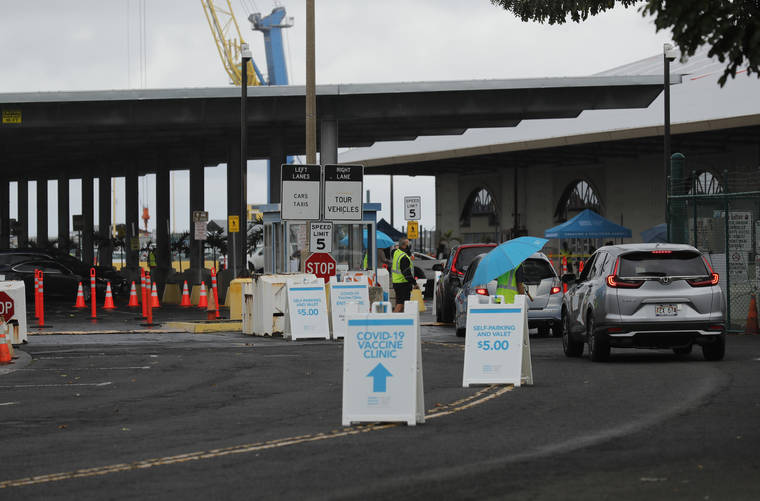Only 8.8% of Native Hawaiians and Pacific Islanders have received COVID vaccine, DOH says

STAR-ADVERTISER
Vehicles drove up at the first mass COVID-19 vaccination clinic at Pier 2, Jan. 18, in Honolulu. New data on vaccinations by race released today by the Department of Health show Asians with the highest immunization rate with 25.4% receiving at least one shot, followed by whites at 19.2%, blacks at 6.4% and other races at 1.9%.
Three months into Hawaii’s vaccination campaign, only 8.8% of Native Hawaiians and Pacific Islanders have received immunizations though they represent more than 40% of COVID-19 cases in the islands.
Asians have the highest immunization rate with 25.4% receiving at least one shot, followed by whites at 19.2%, blacks at 6.4% and other races at 1.9%, according to new data released today by the Department of Health. The information does not include inoculations given by the military.
Vaccine data on Filipinos, which are disproportionately affected by the disease at 19% of total infections, was not available because they are combined in the Asian category. The DOH is asking the federal government to break out the high-risk group, as well as the Native Hawaiian and Pacific Islander category.
“COVID-19 racial and ethnic inequities are linked to long-standing health inequities in cultural communities. Before vaccines were available, Department of Health collected data that has indicated that Native Hawaiians and Pacific Islanders have relatively high hesitancy towards getting vaccinated,” Dr. Sarah Kemble, acting state epidemiologist, said in an online news conference. “When we look at the state population as a whole, it lays out the work ahead of us in achieving equity.”
Contributing to the disparities is that vaccines were initially allocated for health care workers and those 75 and older, she said.
“As we look at who are the health care workers, we see underrepresentation of Native Hawaiians and Pacific Islanders in that category. Then with 75 and older, unfortunately, Native Hawaiian and Pacific Islanders don’t have as long a life expectancy so we have fewer in that category.”
Don't miss out on what's happening!
Stay in touch with breaking news, as it happens, conveniently in your email inbox. It's FREE!
Other challenges to reaching these high-risk groups include cultural and language barriers, as well as technology, mobility and geography, the DOH said, in addition to income and education level.
“All of these things come into play when addressing vaccination disparities.”
The Health Department, which released a new report detailing the racial and ethnic disparities in COVID-19 infections and deaths, is working with local pharmacies and organizations to reach the ethnic groups through mobile vaccination clinics in their neighborhoods and the health centers that serve those communities.
The efforts include using native language speakers to help with outreach, making vaccine information available in 16 languages, training more community health workers, building relationships with church and other influential leaders, establishing virtual town hall meetings and supporting federally qualified health centers in vaccine distribution.
“For our community, it’s not that we’re not wanting it. We want to understand, we want our questions answered, we want to see what happens,” said Sheri-Ann Daniels, executive director of Papa Ola Lokahi, which promotes Native Hawaiian health. “Messages can be very confusing. The platform is confusing for many in our community. We’re finding that they often need some additional help.”
In addition, mass vaccination sites that started in Kakaako aren’t always accessible to those communities, said May Rose Dela Cruz, co-author of the report and assistant researcher for Native Hawaiian and Indigenous Health at the University of Hawaii Office of Public Health Studies.
“Our elderly don’t have access to that … sometimes it’s not within the bus line, there’s no transportation for them, said Dela Cruz, representing the Filipino community. “It’s best to push it out in the communities — the Catholic churches — that’s where we’re at for Filipinos. That’s the case for many of our vulnerable and minority populations, bring it to the rural communities and help us get it out to our people.”
Health officials recorded 48 new coronavirus infections, bringing the state’s total since the start of the pandemic to 28,352 cases. The statewide death toll remains at 451 with no new coronavirus deaths reported. At least 483,108 vaccines have been administered of the 612,900 received by the state, according to the Hawaii COVID-19 vaccine summary.
The new cases include 30 on Oahu, seven on Maui, eight on Hawaii island, one on Kauai and two Hawaii residents diagnosed outside the state, according to health officials. As a result of updated information, state health officials removed one Oahu case from the counts.
The statistics released today reflect the new infection cases reported to the department on Sunday.



